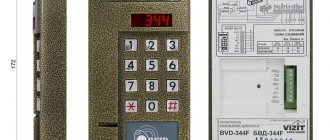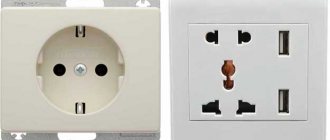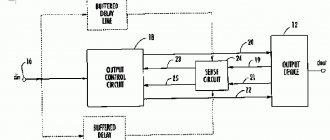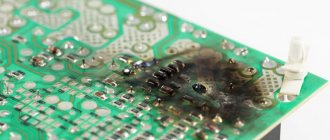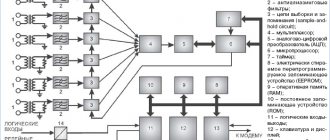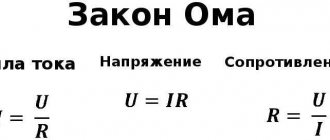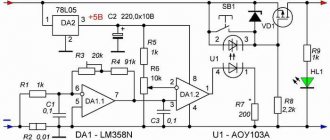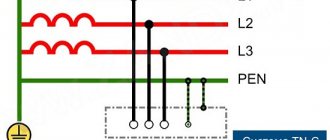Differential current protection is one of the types of relay protection, which is characterized by high efficiency and also has relatively good response speed. It is used both for power equipment (motors, transformers, generators and bus sections), and recently it has become widely used to protect household objects from phase faults. This became possible due to special compact devices similar in design to a regular circuit breaker.
However, some power equipment is simply required, according to power supply regulations, to be equipped with high-speed differential relay protection. Among the varieties of DFZ, there are two main types:
- longitudinal;
- transverse
In order to understand whether differential phase protection is needed for a particular electrical equipment and how to implement it, you need to understand the principle of its operation, as well as understand the installation nuances.
Operating principle of differential protection
The action of this protection is based on comparing the currents that enter and exit the area in need of protection. For such a comparison of current values, current transformers are used, since only through them is it possible to measure large current values. This is best seen in the simplest diagram below.
In the diagram, the current transformers are designated TA1 and TA2. Their secondary circuits are connected to the KA current relay. Thus, it turns out that the winding of the main protection relay receives the difference in current values from the two transformers, and during normal operating processes it will be equal to zero, which means the KA relay will remain unplugged. However, if an interphase short circuit (short circuit) occurs in the circuit that is being protected, then the relay winding will receive a value equal to the sum of several currents, this will set in motion the moving part of the electromechanical relay, which, in turn, will close the contacts and will give a signal to disconnect the equipment from the source of electrical energy. However, this is all in theory, but in practice a certain small unbalance current will always flow through the relay coil, which must be taken into account when calculating the coil.
Here are several reasons for this negative phenomenon:
- CTs (current transformers) can have characteristics that differ significantly from each other. To reduce these indicators, more precise transformers are used, manufactured in pairs specifically for this type of protection;
- Due to the magnetizing current arising in the winding of the protected transformer at the moment it is turned on from the idle mode to the operating mode with a load present. In order to avoid false operation of the KA relay, it is necessary to select a relay operation current greater than the highest value of the magnetizing current that the protected object, in this case a transformer, can produce;
- Due to different connections of windings (star-delta and vice versa). To do this, you need to select the number of turns of current transformers involved in differential protection in such a way that they compensate for these unfavorable values.
The unbalance current in differential protection that occurs during operation is a negative phenomenon that must be combated and which must be taken into account when calculating this protective electrical equipment.
Tire differential protection
DZSh is a fast-acting protection with absolute selectivity, which covers all switchgear elements connected to the busbar section, and acts without delay in case of all types of short circuits (SC) to disconnect the circuit breakers of these elements with the launch of their breaker failure and prohibiting their automatic reclosure in case of unsuccessful automatic reclosure of the busbars. According to its principle of operation, the emergency protection device does not operate falsely during external short circuits and swings.
Modern DPSs are provided with additional braking to tune out unbalance currents in steady-state and transient modes during a long-term external short circuit with a large aperiodic component.
The DPS is connected to separate secondary windings of current transformers (CTs) in such a way that its coverage area overlaps as much as possible with the connection protection coverage areas:
- connection protections are connected to the secondary windings of the current transformers located as close as possible to the busbars;
- The DZSh is connected to the secondary windings of the CT, located as far as possible from the busbars towards the connections.
The DZSh provides for monitoring the health of current circuits with an effect on the alarm and automatic blocking of protection in the event of a malfunction. It is possible to:
- prompt release of protection;
- operational output of protection blocking in case of faulty current circuits.
Modern DZSh terminals provide software equalization of arm currents and the installation of intermediate CTs is not required.
DZSh includes:
- starting current organ;
- sensitive current organ (CTO).
The starting element has a large (relative to WHAT) operating current setting and is designed to disconnect the bus section in the event of a short circuit on the buses.
WHAT is normally taken out of operation and put into operation in the following modes:
- when promptly testing a section of busbars with voltage from one of the connections in the event of unsuccessful automatic reclosure of the busbars, it is entered promptly;
- when autotesting a section of busbars with voltage through the action of automatic reclosure of the busbars, it is entered automatically;
- in the event of a failure of the circuit breaker of one of the connections during the operation of the emergency protection switch, it is entered automatically for a time sufficient for the normal operation of the breaker failure protection.
In these modes, the current of only one connection flows to the short circuit on the busbars, and its value may be insufficient to trigger the starting element, and in the event of a failure of the switch of one of the connections, to hold the starting element in the triggered position for the operation of the breaker failure.
After operation of the automatic protection system, automatic reclosure of the tires can be used.
| Here I would like to see: Add a section with a selection of parameters |
Tire differential protection (TIP)
Features of the application and operation of various transformer protections
Busbars and busbar assemblies are a key reliable current-carrying element of an electrical installation, connecting the voltage source to the switchgear or the operating unit itself. It is characterized by high load capacity and the ability to visually monitor the condition of insulators. At the same time, many people know that it is necessary to implement circuits that protect electrical equipment, but the busbars very often remain unprotected.
Main types of tire damage:
- Incorrect or erroneous manipulations by maintenance personnel with switching of bus disconnectors;
- Phase overlap or short circuit to ground due to deterioration of insulation through contamination of insulators;
- Breakdown during aggressive atmospheric phenomena (thunderstorm, lightning);
- Malfunctions of the disconnector insulators on both sides.
To protect busbars, differential current protection is mainly used. The principle of its operation is similar, and is based on comparing the currents in the connections of the protected buses. When the busbars are in normal operating condition, only unbalance current flows in the differential protection relay coil, which does not operate the relay moving mechanism. During a phase fault, the protection relay will receive a current whose value will be equal to the sum of all currents supplying the connection where the breakdown occurred.
The main advantages of such protection are:
- High response speed;
- Excellent selectivity;
- Relatively simple implementation.
There is only one drawback here - it is a false alarm, which is most often possible when the installation (connecting) wires break, which can occur due to various reasons, both electrical and mechanical. In order to minimize the probability of false triggering, it is necessary to select the operating current of the DPS a little more than the operating current of the most powerful connection. The coverage area of this protection is limited directly to the gap where the CTs are installed; its operation is aimed at disconnecting all supply connections from voltage. To manually monitor the unbalance current, a milliammeter is installed on the control panel and maintenance personnel are required to check it by pressing the corresponding button. Personnel are required to perform this action once per shift, recording it in the operational log.
The differential protection of the busbar is disabled in the following cases:
- The appearance of a sound or light signal about a malfunction of current circuits or an increase in unbalance current;
- If a new connection has occurred, the current circuits of which are not connected to the protection system, and were not correctly phased;
- During a routine check of this protection.
Tire differential protection - brief description and principle of operation
In order to reduce the negative consequences of a short circuit on current consumers, it is necessary to ensure that the area where the short circuit occurred is turned off in the shortest possible time.
To protect busbars, differential protection is usually used, the operating principle of which is based on comparing the phases and current values in the busbar connections. During normal operation of the bus system, only unbalance current flows in the protection circuit. In the event of a short circuit, a short circuit current begins to flow through the circuit breaker circuit, and the protection is triggered to turn off the relay of the buses supplying the short circuit. DZSh also allows you to reduce the negative effect of:
- loss of system stability;
- breakdown and damage to equipment;
- a significant reduction in bus voltage.
If there is no short circuit in the protected objects, then the differential current under ideal conditions should be equal to zero. In real conditions, unbalance current flows, which can be caused by different CT transformation ratios, protection devices, and other factors. When a short circuit occurs, the current in the circuit breaker circuit increases, as a result of which the connections feeding the short circuit are disconnected.
The main advantages of such a protection system are its high response speed and selectivity of shutdown. In addition, emergency protection devices are easy to implement and are triggered in case of any types of short circuit. Among the disadvantages of differential protection is the possibility of operation if the connecting wires break. To avoid false triggering, the triggering current is set slightly higher than the operating current of the most powerful connection.
Most often, the protective shield is used to ensure safety at substations with a double busbar system, which are the most common in our country, and one protective shield is used for both systems, as well as in a single busbar system.
The DZSh includes the following performing elements:
- electoral authorities;
- sensory organ;
- launching organs;
- body that controls the voltage on the tires.
Differential protection is fundamental for tires. To increase the reliability of protection, the following methods are used:
Source
Longitudinal differential generator protection
Features of installation of electrical equipment
To protect various generators from multiphase short circuits. longitudinal differential protection has received the most widespread use. It is connected in the same way as the previous one to the CT, only they are installed from the zero point of the generator, as well as from the terminals. Its coverage area is:
- windings of an electric machine;
- stator output;
- buses or cables that are laid to the switchgear.
The operation current of such protection is set according to the condition of setting the unbalance current passing through the differential protection relay during external short circuits. A protection circuit for a high-sensitivity generator is presented, using the most reliable RNT relays for this case.
The operation current of such a circuit is set according to two conditions:
- Setting the actual unbalance current;
- Setting the current that will flow when the installation wires break.
Generator transverse differential protection
Features of the application and use of the RCD device
This protection is performed to protect against vik short circuits that can occur directly in the stator winding, and, of course, if there are parallel branches of the stator windings. This is possible by comparing the current values of these branches for each phase. Transverse differential protection is carried out in such a way that for each of the phases it is organized separately, that is, it will respond to interturn short circuits only in one of the phases.
The current at which the transverse differential protection coil is drawn in is adjusted according to the maximum unbalance current that can flow in the relay during various external short circuits, and is taken equal to:
When setting up a differential protection system, it is recommended to make a more accurate calculation of the setting, taking into account absolutely all actual unbalance currents flowing, and not calculated ones. As experience shows during operation, on turbogenerators they are relatively small, and their operating current does not require additional adjustments and adjustments. On hydrogenerators, on the contrary, the magnitudes of these unwanted currents are large, therefore it is necessary to significantly coarse the settings of the relay of this transverse protection, which sometimes reduces its super-efficiency.
As a result, I would like to note that the calculation and configuration of these protections should only be carried out by professionals who have experience in this field, most often these are engineers from electrical design bureaus. Differential phase protection in everyday life is also very effective and even a novice electrician can perform it on the basis of compact devices sold in specialized stores; there should not be any connection difficulties. The main thing is to follow basic electrical safety rules.

